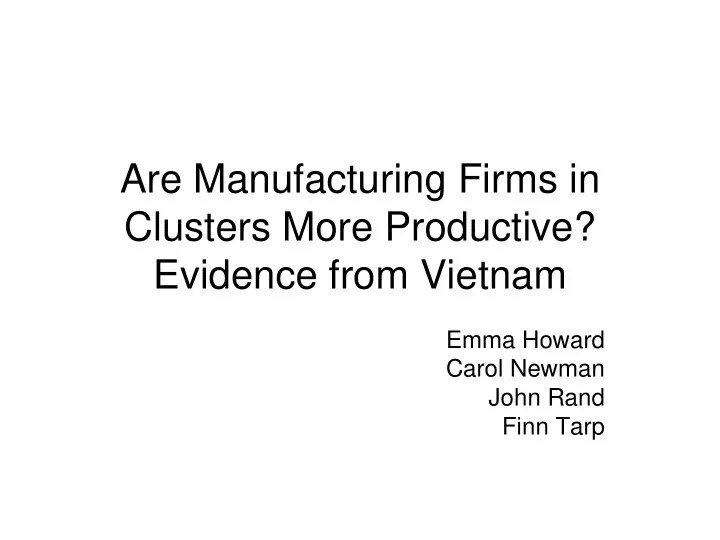

Are Manufacturing Firms in Clusters More Productive? Evidence from Vietnam Emma Howard Carol Newman John Rand Finn Tarp
Motivation • Clustering facilitates growth • Empirical evidence of agglomeration economies • Limited empirical evidence linking clustering to firm performance • Number of mechanisms through which firms in clusters may be more productive • Firms may ‘self select’ into productive clusters
Contribution • We use a rich and unique data set of firms from Vietnam • We extend the Olley Pakes (1996) approach to control for self selection • This allows us to identify how locating in a cluster impacts on firm productivity • Future work will attempt to uncover the mechanisms
Data • Vietnamese Enterprise Survey for 2002- 2007 (GSO, 2010) • Unbalanced Panel, all registered manufacturing firms with >30 employees • Information on commune in which firm is located plus assets, employees etc
Methodology • Extend Olley Pakes (1996) approach by controlling for cluster productivity when estimating firm productivity • Similar approach to De Loecker (2007) who controlled for export status Two main parts to the analysis 1) Estimate firm productivity controlling for cluster productivity 2) Estimate the impact of cluster productivity on firm productivity
Olley Pakes Estimation • Traditional productivity estimation→ Cobb Douglas production function, estimate coefficients, then productivity given by; • Results in two main biases; simultaneity and survival bias • OP controls for both in 3 step estimation procedure
Extended OP: Control for Self-Selection Assume: i. productivity follows a first-order Markov process ii. Cobb Douglas Production function iii. Investment monotonically increasing in productivity Proxy productivity by a function in investment, capital and cluster productivity 1st stage: consistent estimate for coefficient of labour 2nd stage: predicted probability of survival 3rd stage: consistent estimate for coefficient of capital
Production Function Estimation = − • Investment given by: i k k − t t t 1 • Output = total revenue of firm • Labour = total number of employees • Capital = total assets at time t • Average productivity of cluster: index number approach to measure TFP for firm i take average of all other firms in cluster firm and cluster specific variable
Production Function Estimation
Production Function Estimation
Production Function Estimation
Methodology (2) • We then estimate the impact of the cluster on the productivity of the firm where
Results
Results
Results
Results
Results
Conclusions and Next Steps Evidence of productivity spillovers Investment necessary to benefit from spillovers Next Steps: Estimate productivity separately for each four- digit sector Robustness checks: other cluster characteristics- labour productivity, size of cluster Mechanisms: technology transfers, foreign firms, competitors
Thank you howardek@tcd.ie
Recommend
More recommend